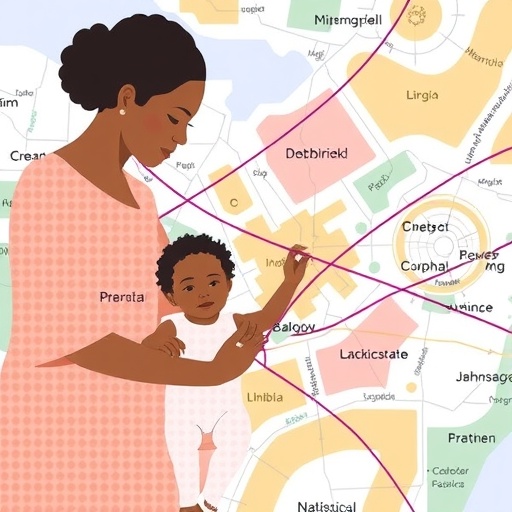In a groundbreaking study that brings forth innovative methodologies to address a deep-seated issue in public health, researchers are making strides in enhancing birth equity through collaborative systems mapping. The work, spearheaded by Thomas S.R., Fatima H., and Simon J., has outlined a strategic roadmap designed to tackle disparities that have afflicted maternal and infant health for generations. This research is a clarion call for policymakers, healthcare providers, and community organizations to unify their efforts in fostering an equitable environment for all women, regardless of their socio-economic background.
Birth equity has emerged as a critical concern over recent decades, marked by stark disparities in maternal and child health outcomes. Factors such as poverty, race, and access to healthcare services have contributed to an uneven playing field in maternal health, whereby marginalized communities face a significantly higher risk of adverse outcomes. This situation demands an urgent response, and the research team’s initiative employs collaborative systems mapping as a pivotal tool for systemic change.
Collaborative systems mapping offers a visual representation of complex interconnections within health systems. This methodology enables stakeholders to visualize the intricate web of influences that contribute to inequities in birth outcomes. By bringing together varied perspectives from different sectors, including health, education, and social services, the approach emphasizes the need for multi-faceted strategies that speak to the root causes of inequity rather than simply the symptoms.
The researchers emphasize that the effectiveness of this collaborative approach relies heavily on participation from diverse stakeholders. This participatory model not only enriches the data collected but also fosters a sense of ownership among contributors, which can lead to more sustainable outcomes. The synthesis of knowledge from different sectors allows for a more holistic understanding of the challenges at hand and encourages the development of tailored interventions that resonate with the unique needs of the community.
One of the highlighted aspects of the research is the role of technology in facilitating these collaborations. The advent of digital tools and platforms allows for real-time data sharing and engagement, making it easier for stakeholders to remain informed and connected. This technological integration serves to streamline communication and elevate the discourse surrounding birth equity, ensuring that discussions are rooted in current data and insights.
As the study meticulously outlines, the implications of successfully achieving birth equity extend far beyond individual health outcomes. Improved maternal health correlates strongly with positive societal benefits, including economic stability, enhanced educational opportunities for children, and a reduction in healthcare costs associated with preventable complications. Thus, the societal impact of advancing birth equity is far-reaching, presenting a compelling case for stakeholder engagement at all levels.
Furthermore, the research provides empirical evidence supporting systemic interventions that have effectively addressed disparities in the past. By analyzing existing case studies and success stories, the authors identify key elements that contribute to effective collaborations. For instance, fostering trust among community partners and ensuring transparency throughout the process are critical components that can enhance the efficacy of collective action initiatives.
In delving deeper into societal structures, the study calls attention to the health policies that perpetuate inequities and advocates for necessary reforms. Policymakers are urged to examine their frameworks and biases which may inadvertently hinder progress towards achieving equitable health outcomes. The roadmap presented by the researchers is not just a theoretical construct; it serves as a call to action for systemic change that is informed by both data and lived experiences.
The framework proposed by this study has the potential to be adapted and applied in various contexts globally. Each community presents a unique tapestry of challenges and opportunities, and thus, flexibility in implementation is crucial. The researchers encourage communities to tailor the collaborative systems mapping approach to fit their specific needs while maintaining core principles of engagement, inclusion, and adaptability.
Addressing the urgency of the issue, the study emphasizes that birth equity should be recognized not only as a health concern but as a fundamental human right. The authors advocate for a paradigm shift in how we perceive and approach maternal health, urging stakeholders to adopt a more comprehensive lens that incorporates social determinants of health. This evolution in perspective is vital for creating a future where all women have an equitable chance at healthy pregnancies and thriving children.
Ultimately, the collaborative systems mapping approach outlined in this research presents a significant advancement in our understanding of how to tackle birth inequities effectively. It allows for the identification of leverage points within the system, making it possible to implement targeted interventions that can yield measurable results. As attention to maternal and child health issues grows globally, this study serves as a pivotal resource for driving forward-thinking solutions that prioritize birth equity.
The call for urgent action in the realm of birth equity is more pressing than ever, with rising awareness of its implications interwoven with social justice, public health, and economic stability. The research presented by Thomas S.R., Fatima H., and Simon J. sits at the intersection of these critical areas, advocating for a comprehensive strategy to address the inequities that plague our health systems. By leveraging collaborative systems mapping, stakeholders across various sectors can forge pathways to a future where every woman, irrespective of her circumstances, experiences the joys and rights of motherhood in an equitable landscape.
As the discourse around birth equity continues to evolve, the findings of this study, published in Health Research Policy and Systems, will likely stimulate further research and action among health advocates, policymakers, and community organizations. By acting on the insights provided, society can ensure that the legacy of maternal health is one of inclusion, equity, and empowerment for all individuals and communities.
In conclusion, the argument for prioritizing birth equity is compelling, underpinned by the shared responsibility of all actors in the health ecosystem. The innovative methodologies introduced by these researchers offer a framework through which collaborative efforts can flourish, ultimately leading us toward a more equitable future in maternal and child health.
Subject of Research: Birth Equity
Article Title: Accelerating birth equity using collaborative systems mapping
Article References:
Thomas, S.R., Fatima, H., Simon, J. et al. Accelerating birth equity using collaborative systems mapping.
Health Res Policy Sys 23, 128 (2025). https://doi.org/10.1186/s12961-025-01373-1
Image Credits: AI Generated
DOI: https://doi.org/10.1186/s12961-025-01373-1
Keywords: Birth equity, maternal health, collaborative systems mapping, public health policy, social determinants of health.
Tags: addressing healthcare inequitiesbirth equity initiativescollaborative systems mapping methodologycommunity engagement in public healthinclusive maternal care strategiesinfant health outcomes improvementmaternal health disparitiesmulti-sectoral approaches to health challengespublic health policy recommendationssocio-economic factors in healthcarestakeholder collaboration for health equityvisual tools for systemic change





